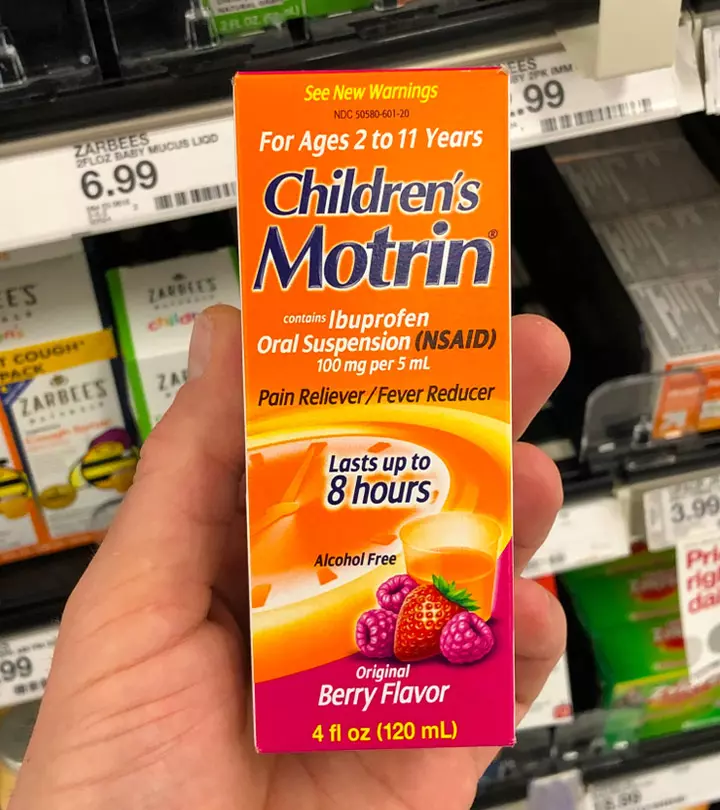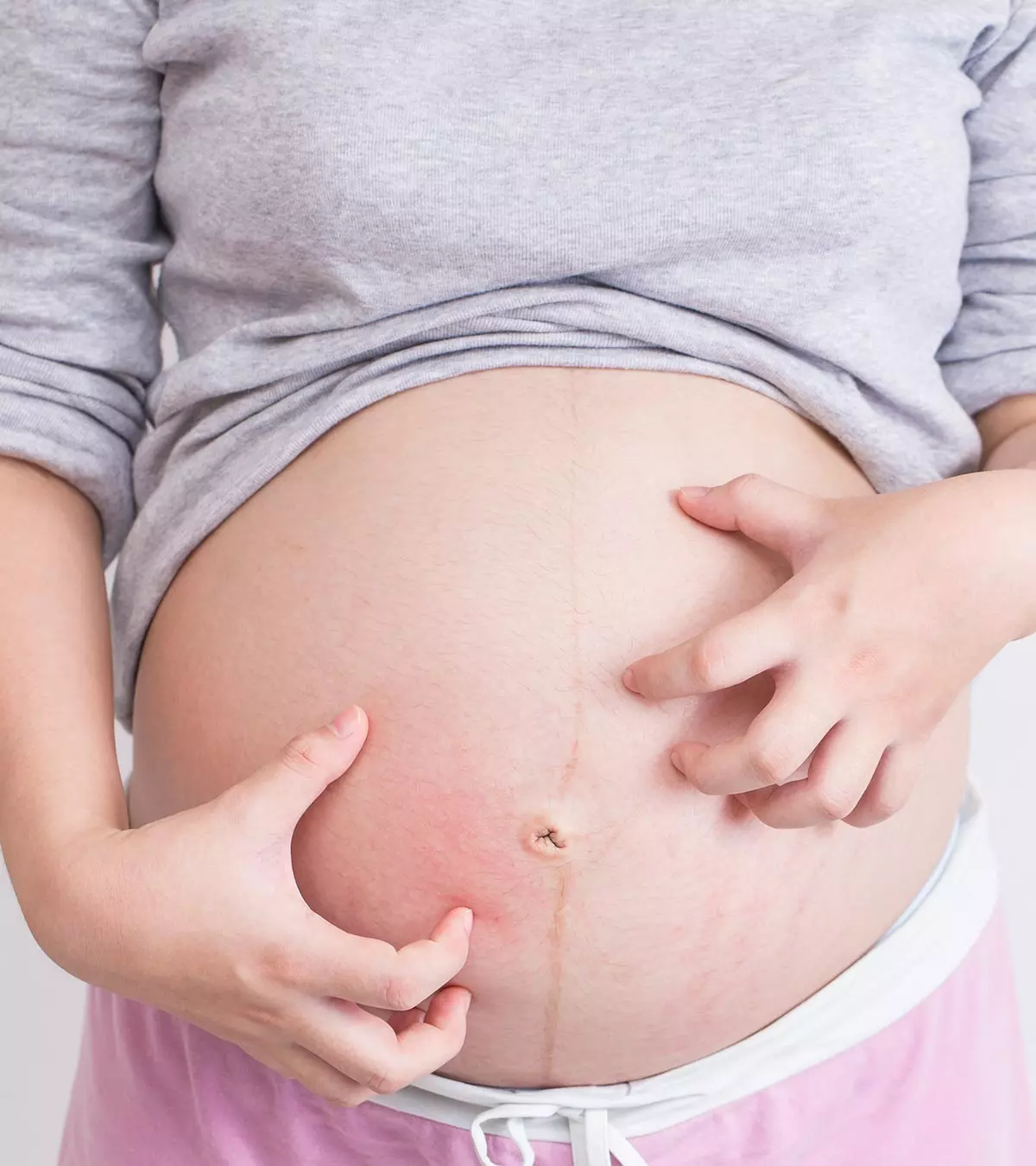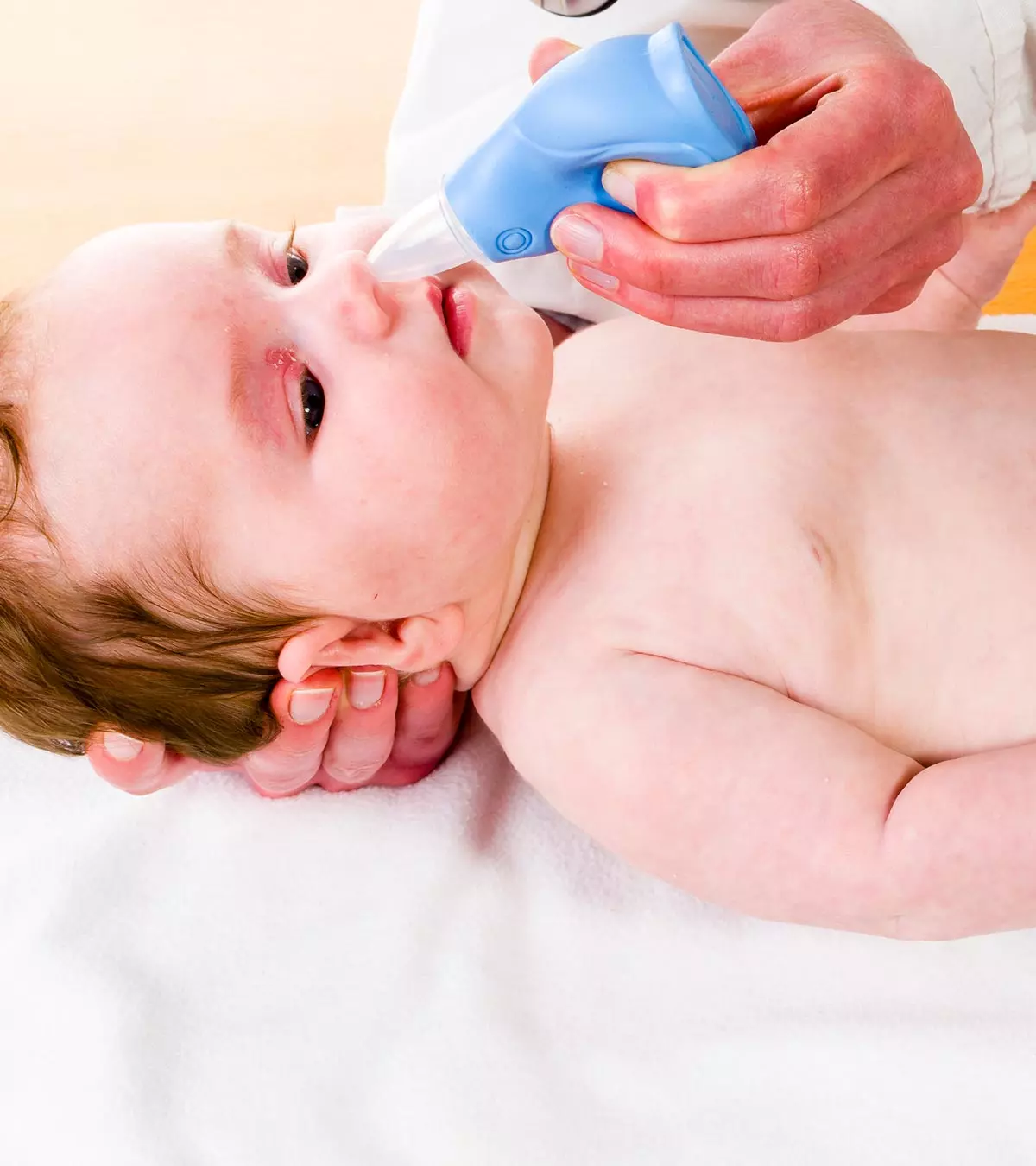
Image: Shutterstock
Impetigo is a bacterial infection that affects the skin. Impetigo in babies may initially appear as harmless blisters but can later spread slowly to the other parts of the body. Further complications may be avoided if this skin condition is diagnosed and treated early.

Continue reading this post as we explain what impetigo is, its causes, types, symptoms, treatment, and effective preventive measures in babies.
Key Pointers
- Group A Streptococcus bacteria or Staphylococcus aureus bacteria cause impetigo, a bacterial skin infection.
- There are three types of impetigo: Non-bullous impetigo, bullous impetigo, and ecthyma.
- Contact with an infected person or item, or an existing rash can lead to impetigo.
- To manage impetigo, cover sores, keep nails short, take diaper breaks, wash hands regularly, and clean sores with warm water.
- Maintaining good hygiene, avoiding scratching sores, using separate personal items for the baby, and keeping the nose cold can prevent impetigo.
What Is Impetigo?
Impetigo is a highly contagious bacterial skin infection caused either by Group A Streptococcus bacteria or Staphylococcus aureus bacteria
(1). The bacteria can infect the upper or deeper layers of the skin.
There are three types of impetigo (2):
- Non-bullous impetigo, also called crusted impetigo or impetigo contagiosa, is the most common type that causes small sores and blisters. Non-bullous impetigo can be caused either by strep bacteria (Streptococcus) or staph bacteria (Staphylococcus). The latter is also the causative agent of toddler staph infection.
- Bullous impetigo is a severe form of impetigo that causes large boil-like blisters that could fill with pus and burst. Bullous impetigo takes longer to heal than non-bullous impetigo. Only Staph bacteria cause this infection.
- Ecthyma is the most severe variation of impetigo where the bacteria infect the deeper layers of the skin. Ecthyma can be a result of infection by strep, staph, or both. Since ecthyma impacts the deeper layers of the skin, it is also called deep impetigo.
What are the Common Forms Of Impetigo In Babies?
Non-bullous is the most common type of impetigo, constituting about 70% of the total impetigo cases in infants and toddlers (3). However, non-bullous impetigo is very rare among babies aged under two years.
While bullous impetigo mostly affects toddlers aged over two years, it can also affect infants and newborns. Ecthyma may often start as bullous or non-bullous impetigo, eventually spreading to the deeper layers of the skin.
How Does A Baby Get Impetigo?
Following are the causes of impetigo in babies:
- Contact with an infected person. A baby can catch the infection through physical contact with anyone with impetigo.
- Touching objects used by an infected person. Touching toys or other personal items of the infected person can also spread the bacteria.

- Infection of an existing rash. Scratching an existing rash, like an insect bite can cause the sore to break. The bacteria that cause impetigo are usually airborne and on the surface of the skin. When the bacteria find an opening in the skin, it colonizes the wound to cause impetigo.
Certain conditions and health background can make some babies more prone to the infection than others.
What Are The Risks Of A Baby Getting Impetigo?
The chances of your baby getting infected by impetigo increase in the following cases:
- Living in hot and humid weather: Impetigo infections are common in the regions with high heat and humidity. In the temperate areas, the disease occurs during summers.
- Having eczema or psoriasis: If your baby has eczema, then they are at a higher risk of developing impetigo since the constant scratching can make the irritant sores prone to infection (4). Even though data is scarce for babies, in 2025, the Centers for Disease Control and Prevention reported varying rates of eczema among children based on age: 12.1% in ages 6-11, 10.4% in ages 0-5, and 9.8% in ages 12-17. To prevent the worsening of eczema to impetigo, it is important to have your baby checked by a doctor when eczema symptoms develop.
- Diseases that affect the skin: Other skin infections also increase the risk of impetigo. An example is scabies, which is caused by scabies mite that burrows into the skin causing large sores that can break (5). A baby with chickenpox can also catch impetigo on scratching and rupturing the chickenpox rash (6).
- Babies at daycare: Babies spending too much time in crowded environments like daycare facilities are at a higher risk of skin infections.
- Baby with a strep throat: Strep bacteria that causes impetigo is also responsible for causing strep throat (7). A baby who has strep throat can pass the bacteria through sneezing or coughing and exposing an open sore on the skin to the bacteria, eventually leading to impetigo.
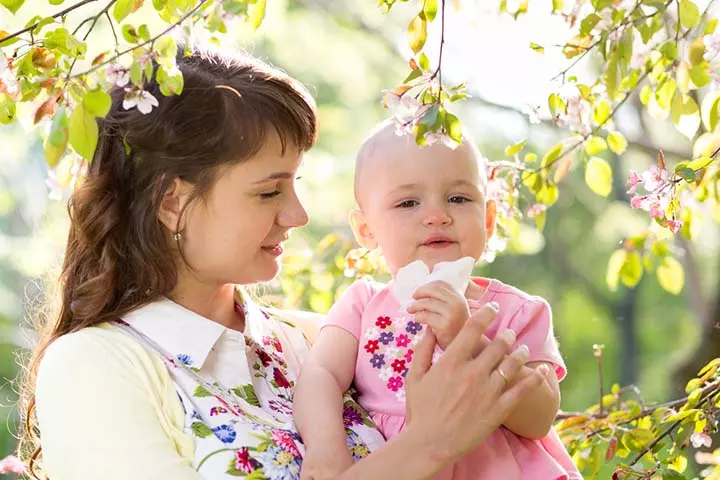
- Age of the child: Impetigo can happen in infants, but is most common among children between the ages two and five years (8).
- Immunosuppressed infants: Babies with suppressed immunity, especially those with HIV, are at a greater risk of developing bacterial infections like impetigo (9).
If your baby belongs to the risk group, then keep checking for the symptoms of impetigo.
What Are The Symptoms Of Impetigo In Babies?
The first symptoms of impetigo can emerge anywhere from a day to ten days after contracting the bacteria. They may vary depending on the type of impetigo.
Symptoms of non-bullous impetigo
- The earliest symptoms of this impetigo are redness around the nostrils and the skin above the upper lip.
- The fine red rashes turn into large blisters, spreading across the healthier skin on the nose and chin.
- Rashes soon take the shape of yellowish-red lesions or blisters. The yellow color is due to pus, which are clusters of white blood cells that attack the invading bacteria.
- The blisters burst and the lesions appear damp due to the fluid.
- After a few days, the broken blisters may turn brownish-red or honey-colored, with an outline of red crusting around the sore. The sore begins to dry at this stage and forms a flaky crust.
- The sores are not painful, but the itching can be severe, and the baby may attempt to scratch them repeatedly, which may result in swelling.
Symptoms of bullous impetigo

- The first symptom is the development of pink to red-colored lesions on the skin in various parts of the body.
- Gradually, the blister grows larger and develops a clear fluid within.
- The fluid gradually turns yellow due to the pus. The lesion itself begins to grow in size while also forming several smaller blisters around it.
- The blister bursts and the fluid drains away. The upper sheath of the blister dries and forms a white outline around the lesion, which stays red to dark pink for several days.
- Bullous impetigo blisters mostly appear around skin folds, such as the diaper region and the neck folds.
 Quick fact
Quick factSymptoms of ecthyma
- Large pus-filled sores that mostly appear on the legs (10). Ecthyma sores may also appear on the buttocks.
- The sores get wider with a perforated circumference. You can tell the sore is quite deep by observing how sunken the center of the lesion appears.
- The sore can even get wider than an inch. Ecthyma sores can be itchy but are mostly painful.
- The sore dries, losing the yellow color to turn purple-red.
Sometimes, the baby may also develop a mild fever while the bacteria spread rampantly to the healthy skin. So take your baby to the doctor if you suspect they have impetigo.
How Is Impetigo In Babies Diagnosed?
A doctor can diagnose impetigo by visually assessing the sores. In some cases, the doctor may take a scraping from the sore or a sample of the fluid from the blister and send it for laboratory analysis. The presence of bacteria in the sample will confirm impetigo.
How Is Impetigo In Babies Treated?
The following two measures help treat impetigo in babies (11):
1. Topical antibiotics: The compound called mupirocin is the most effective topical antibiotic for impetigo treatment (12). A pediatrician or dermatologist may prescribe a mupirocin cream or an ointment with mupirocin and other compounds, depending on the extent of the infection.
Antibiotic creams are applied liberally to the affected parts. The doctor may also suggest using warm water to clean the sores. This helps remove the crusts of the dead skin, thus making the skin permeable to the cream. As they have no side effects, topical antibiotic creams are often the first choice for treating impetigo in babies.
2. Oral antibiotics are preferred when impetigo has spread to a larger part of the skin. Common oral antibiotics used for impetigo treatment are penicillin and amoxicillin (13). Oral antibiotics have several side effects including severe abdominal discomfort and are avoided by pediatricians unless necessary.
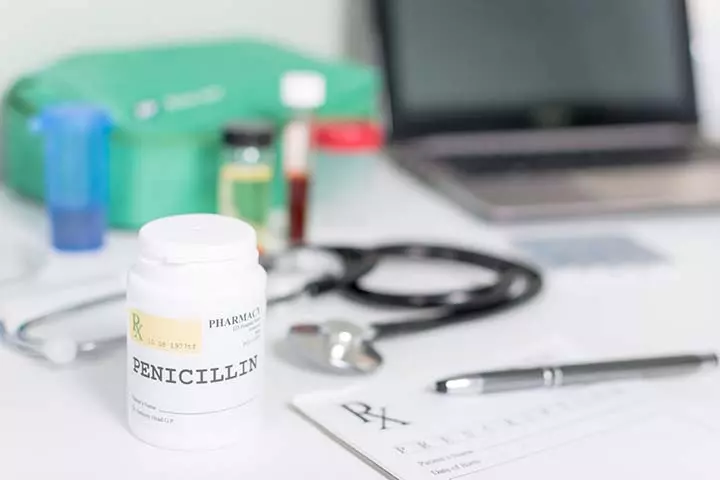
The baby will start feeling better within a few days of commencing the treatment. The infection will resolve completely within ten days to two weeks, depending on the extent of the infection.
Complete the entire course of medication even if the baby shows improvement within days. Completing the antibiotic course helps minimize recurrence and also prevents the bacteria from becoming antibiotic-resistant.
Non-bullous and bullous impetigo does not leave scars, but ecthyma blisters may cause scarring. While treatment with medicines is vital, appropriate home management is also essential.
How Can Parents Manage Impetigo In Infants?
Here are a few tips to help the baby recover faster and prevent the chances of spreading the infection (14) (15):
- Keep the sores covered. Dead skin from the sores and fluid from the blisters can spread the disease to the rest of the body, and to other people coming in contact with the baby. Therefore, it is important to keep the sores covered. Dress the baby in loose clothing that covers the scars but also allows ventilation. You can also cover the sores with loose gauze bandages.
- Trim the baby’s nails. Impetigo often spreads from the infected to the healthy skin through the fingernails. Trim the baby’s nails to ensure that the bacteria do not accumulate under the nails. Clipping the nails also minimizes the chances of scratching and bursting the blisters.
- Give diaper breaks. Bullous impetigo can cause sores around the diaper area. Let the baby stay without a diaper for a few minutes every day to air-dry the affected part. Air circulation allows the sores to dry quicker, which can accelerate the healing process.
- Wash the baby’s hands periodically. Your baby may accidentally touch a sore and place the hand on other parts of the body or a caretaker’s skin. Wash the baby’s hands with a safe disinfectant soap once every six hours to prevent the accumulation of the strep and staph bacteria on the palms.
- Clean sores once a day with warm water. Besides a warm water bath every day, clean the sores once every eight to 12 hours with warm water. Your baby’s pediatrician can prescribe a water-soluble anti-bacterial liquid to add to the water.
- Wash the baby’s laundry separately. Use warm water to wash the baby’s clothes separately. Use a disinfectant detergent to do the washing. Also, wipe clean the baby’s toys, and other personal items with a towel dipped in the disinfectant liquid.
- Stay indoors. Avoid going to the park or sending your baby to daycare. An infant with impetigo can quickly spread the disease to other healthy infants around them.
- Family members must observe precautions. Primary caretakers must wash hands every time they clean the baby’s sores. It is best to wash hands after you hold the baby or their items of use. Ask other members of the family to keep a distance from the infant and do not touch the baby’s items.
Impetigo stops being contagious 48 hours after the treatment begins (16). Nevertheless, it is best to observe precautions until the sores dry entirely.
 Caution
CautionClose contact with an infected individual may also lead to reinfection or recurrent infection. Linda, a mom blogger, shares her experience with her son having impetigo for an entire school year despite receiving treatment. She says,”My son was in the fourth grade and kept impetigo all one school year. He took antibiotics and used a cream, repeatedly. Yet, I could not eradicate it after multiple doctor visits. Finally, in the summer, another swim team mother complained at the pool that her son kept impetigo all the school year. Her husband, a vet, had medicated the child all year. Both our children suddenly had no more impetigo when school was out. I reminded her that our sons sat front and back of each other. When I told her my son had impetigo all year, too, we realized our children were infecting each other (i).”
Can Impetigo In Babies Go Away Without Treatment?
Yes, impetigo can resolve in 10-12 days without treatment.
However, the American Academy of Dermatology states that skipping impetigo treatment can cause the bacteria to infect the deeper layers of the skin, leading to complications (17), which can be fatal for an infant. Hence, do not leave your baby’s impetigo untreated.
Dana Harum, a mom blogger, shares her experience with her baby’s skin infection. She noticed a rash on her baby’s skin and initially thought it was due to the hot weather. She mistakenly applied an itchy powder to the rash for about three days. However, she soon realized that something was wrong. She explains, “The skin is getting worse, and it’s not just a rash; her skin looks blistered and watery like burns. I decided to bring her to a pediatrician, and the diagnosis was that she had a skin infection called Impetigo (ii).”
This serves as a clear example of why timely diagnosis and treatment are essential to prevent the infection from becoming more widespread and causing complications in babies.
What Are The Complications Of Untreated Impetigo?
Untreated impetigo can cause the following complications in babies:
- Erysipelas: It is a condition where the bacteria create a widespread infection of the top layer of the skin. The condition causes large parts of the body to turn red due to infection. The infection is fairly common, and an ignored and untreated impetigo can increase the risk (18) (19).
- Cellulitis: It is similar to erysipelas, but here the bacteria affects the deeper layers of the skin. Cellulitis can be fatal since the bacteria can quickly pass into blood and muscles from the lower layers of the skin. Once in the blood, the bacteria may reach multiple organs of the body, causing widespread complications including permanent damage to some organs (20) (21).
- Glomerulonephritis: If the strep bacteria reaches the kidneys, it causes glomerulonephritis (22). The small coils of blood vessels within the kidneys, called glomerulus, get inflamed and have difficulty filtering the blood to form urine (23).
- Scarlet fever and rheumatic fever: They result in severe sore throat pain and rashes all over the body (24). Scarlet fever in babies can progress to rheumatic fever, which causes severe damage to essential organs like the heart and brain (25).
Treatment helps your baby avoid complications. But prevention is always better than cure.
How To Prevent Impetigo In Babies?
Help lower the chances of your baby getting impetigo by taking the following preventive steps.
- Maintain good hygiene: Impetigo is caused by strep and staph bacteria that are commonly found in the environment. Follow basic hygiene in your home and around the baby. Washing hands soon after using the toilet and coming in from the outdoors is important to keep infections like impetigo at bay.
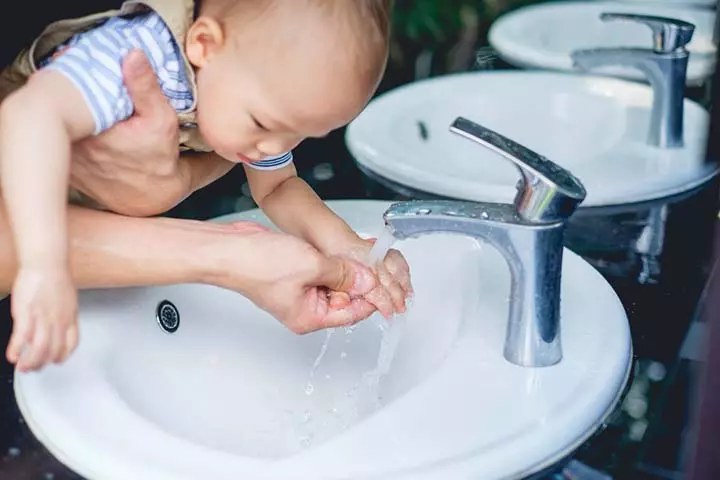
- Avoid sending the baby to daycare: If you have a chance, then avoid sending your little one to the daycare center. An infant can contract impetigo from another infant or a caretaker at the facility.
- Prevent scratching of wounds and open sores: If your baby has a wound or an insect bite, then keep it covered with loose gauze bandages to discourage scratching. Trimming nails is also an excellent preventive measure.
- Do not share personal items with the baby: Maintain separate towels, clothes, and utensils for a baby. Do not share them even with the baby’s siblings. Impetigo can unknowingly pass from a person to another through the use of common items.
- Keep the nose clean when the baby has a cold: Strep and staph bacteria often colonize the nose and cause cold with a runny nose. Medical experts suggest spreading a layer of anti-bacterial cream on the baby’s upper lip and around the nostrils to prevent bacteria from infecting the skin (26). You can consult your baby’s pediatrician to learn about the appropriate anti-bacterial cream.
Frequently Asked Questions
1. What can be mistaken as impetigo?
Impetigo is often confused with skin conditions such as contact dermatitis, cellulitis, scabies, and insect bites (27). Thus, you must consult a doctor to make the correct diagnosis and initiate suitable treatment.
2. Is impetigo caused by poor hygiene?
Poor hygiene doesn’t cause impetigo. However, it increases one’s risk of contracting the infection (28). Thus, one should maintain good hygiene with regular handwashing and bathing or showering.
3. Are there any home remedies for treating impetigo in babies?
Home remedies, like soaking the affected area in warm water, gently cleansing with antibacterial soap, and using antibiotic ointments, can help with impetigo in babies (32). However, it is important to consult a healthcare professional for proper diagnosis and treatment. Home remedies must be used cautiously and with professional guidance.
4. Are there any specific hygiene practices that can help prevent impetigo in babies?
To prevent impetigo and similar bacterial infections in babies, ensure cleanliness by gently washing their skin with mild soap and water. Promote regular and thorough handwashing, refrain from sharing personal items, utilize separate towels, and keep their fingernails trimmed. By following these practices, you can effectively lower the chances of impetigo occurrence and its transmission among family members and others (33).
5. What are the differences between impetigo and other common skin infections in babies?
When comparing impetigo to other skin infections commonly seen in babies, there are notable differences in their causes, symptoms, spread, and treatment. Impetigo is caused by bacteria and can easily spread from one baby to another, whereas diaper rash is a preventable irritation that can be avoided with proper diaper care. Conversely, eczema is a chronic skin condition influenced by both genetics and the environment. To ensure accurate diagnosis and appropriate treatment, consulting a doctor is crucial (8) (34) (35) .
While impetigo blisters may look innocuous, they will quickly spread to other body parts. Among the different impetigo types, non-bullous is most common in babies. Therefore, do not overlook any crusty, yellowish sores on your baby’s skin. The risk of impetigo infections in newborns increases with hot, humid conditions, contact with sick babies, strep throat infection in babies, and other factors. So, if your baby exhibits any symptoms, see a doctor immediately. With proper therapy and antibiotic usage, impetigo symptoms will fade after two weeks.
Infographic: How Can One Differentiate Among Different Types Of Impetigo?
Impetigo is a contagious bacterial skin infection affecting anyone, including babies. However, early treatment can help in effective management and preventing complications associated with this condition. Check out the infographic below to learn about various types of impetigo in babies and their symptoms to detect rashes during the early stages.
Some thing wrong with infographic shortcode. please verify shortcode syntaxLearn about impetigo, a contagious skin infection. Find out its causes, signs and symptoms, diagnosis, and treatment options from this informative video.
Personal Experience: Source
MomJunction articles include first-hand experiences to provide you with better insights through real-life narratives. Here are the sources of personal accounts referenced in this article.
i. Cheap protection.https://practical-parsimony.blogspot.com/2013/05/cheap-protection.html
ii. The mistakes that I’ve done when my baby was infected by Impetigo.
https://danaharum.medium.com/the-mistakes-that-ive-done-when-my-child-infected-by-imtigo-9156437b9fc8
References
- Impetigo.
https://www.health.harvard.edu/a_to_z/impetigo-a-to-z - Naomi M. Nardi; Timothy J. Schaefer; (2025); Impetigo.
https://www.ncbi.nlm.nih.gov/books/NBK430974/ - Luciana Baptista Pereira; (2014); Impetigo – review.
https://www.ncbi.nlm.nih.gov/pmc/articles/PMC4008061/ - Impetigo (school sores).
https://www.healthywa.wa.gov.au/Articles/F_I/Impetigo-school-sores - Lucia Romani et al.; (2015); Scabies and Impetigo Prevalence and Risk Factors in Fiji: A National Survey.
https://journals.plos.org/plosntds/article?id=10.1371/journal.pntd.0003452 - Impetigo.
https://winchesterhospital.org/health-library/article?id=11752 - Group A Streptococcal (GAS) Disease.
https://www.cdc.gov/group-a-strep/ - About Impetigo.
https://www.cdc.gov/group-a-strep/about/impetigo.html - Health and Safety in the Child Care Setting: Prevention of Infectious Disease.
https://cchp.ucsf.edu/sites/g/files/tkssra181/f/idc2book.pdf - Ecthyma.
https://medlineplus.gov/ency/article/000864.htm - Impetigo: Overview.
https://www.ncbi.nlm.nih.gov/books/NBK279537/ - Impetigo: What can make it go away faster?
https://www.ncbi.nlm.nih.gov/books/NBK279536/ - Charles Cole and John Gazewood; (2007); Diagnosis and Treatment of Impetigo.
https://www.aafp.org/pubs/afp/issues/2007/0315/p859.html - Impetigo.
https://www.healthychildren.org/English/health-issues/conditions/skin/Pages/Impetigo.aspx - 12 Common Summertime Skin Rashes in Children.
https://www.healthychildren.org/English/health-issues/conditions/skin/Pages/Common-Summertime-Skin-Rashes-in-Children.aspx - Impetigo.
https://www.nhs.uk/conditions/impetigo/ - IMPETIGO: DIAGNOSIS AND TREATMENT.
https://www.aad.org/public/diseases/a-z/impetigo-treatment - Erysipelas.
https://winchesterhospital.org/health-library/article?id=917220 - Erysipelas and cellulitis: Overview.
https://www.ncbi.nlm.nih.gov/books/NBK303996/ - Cellulitis.
https://www.nhs.uk/conditions/cellulitis/ - CELLULITIS: DIAGNOSIS AND TREATMENT.
https://www.aad.org/public/diseases/a-z/cellulitis-treatment - Impetigo.
https://my.clevelandclinic.org/health/diseases/15134-impetigo - Glomerulonephritis in Children.
https://www.urmc.rochester.edu/encyclopedia/content?ContentTypeID=90&ContentID=P03085 - Symptoms of Scarlet Fever.
https://www.cdc.gov/group-a-strep/about/symptoms-of-scarlet-fever.html - Rheumatic Fever.
https://www.urmc.rochester.edu/encyclopedia/content?contenttypeid=90&contentid=P01728 - Impetigo: Tips for Treatment and Prevention.
https://findado.osteopathic.org/impetigo-common-skin-infection-children - Impetigo.
https://www.healthdirect.gov.au/impetigo - Impetigo Fact Sheet.
https://www.pa.gov/spdocsothers/topics/Documents/Diseases%20and%20Conditions/Impetigo.pdf - Impetigo
https://www.healthdirect.gov.au/impetigo - Guttate Psoriasis.
https://www.rileychildrens.org/health-info/psoriasis - Septicaemia.
https://my.clevelandclinic.org/health/diseases/21539-septicemia - Impetigo in Children.
https://www.urmc.rochester.edu/encyclopedia/content?ContentTypeID=90&ContentID=P01905 - Impetigo in Children.
https://myhealth.ucsd.edu/breatheeasy/90// - Ulrike Blume-Peytavi and Varvara Kanti; (2018); Prevention and treatment of diaper dermatitis.
https://pubmed.ncbi.nlm.nih.gov/29596731/ - Eczema – Atopic Dermatitis.
https://medlineplus.gov/eczema.html
Community Experiences
Join the conversation and become a part of our nurturing community! Share your stories, experiences, and insights to connect with fellow parents.
Read full bio of Dr. Nandita Chatterjee
Read full bio of Rohit Garoo
Read full bio of Dr. Ritika Shah
Read full bio of Shinta Liz Sunny

 Point to consider
Point to consider




